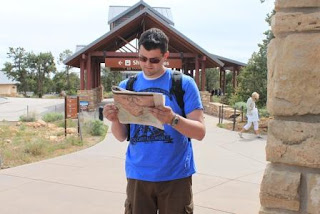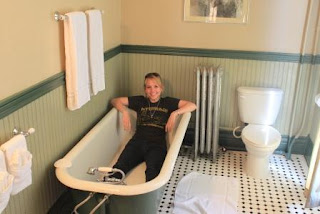Because neither of us had been to Las Vegas, we took one more overnight detour on our way to California. By the time we reached the Strip, our beloved Elvis was groaning in pain every time we touched the breaks - so we traded him for Marilyn and believe he ended up in the right town anyway.
 |
| So sad to leave Elvis behind. |
 |
| Marilyn has a sunroof! |
 |
| Coming into Vegas. |
Perhaps due to a glitch in the Priceline system, we got an outrageous deal on a room at Vdara - a new hotel in the heart of the Strip known for luxurious rooms and a sunny 'death-ray' created by the angle of the building's glass exterior. Around noon every day, the sun's reflection off the Vdara concentrates on a small portion of the pool deck and is strong enough to burn hair and melt plastic. We stayed inside.
 |
| View of the Strip and the Bellagio Fountain from our room by night. |
Santa Monica Pier: The End of the Road
The last leg from Las Vegas to Santa Monica was the longest stretch of our journey. After reconnecting with the Route in Barstow, CA, we passed through a number of small cities on our way through the sprawling metropolis surrounding Los Angeles. Compared with other sections of Route 66, many of the businesses and communities in California are thriving. In some towns along the road in Missouri or Oklahoma, populations range from 200-800 people. Coming into LA, places like Rancho Cuccamonga and Victorville have north of 100,000 residents. Even in these places, where the Route is not the only road through town, historic signs are everywhere.
As expected, we encountered more traffic in the last 30 miles into Los Angeles than we did during our entire trip. For a couple of weary travelers, our only solace from the congestion was the rapidly cooling temperature (88 in the Mojave desert, 65 in Santa Monica) and the scent of the ocean in the air.
Through downtown LA, the route turns into Sunset and then Santa Monica Boulevards, passing through West Hollywood and Beverly Hills before entering Santa Monica. We anxiously counted down the final miles as soaring palm trees lined our approach to the coast.
As the Pacific came into view, we turned onto Ocean Avenue, arriving at our beachfront hotel. Splurging a bit for our last stay, we checked into the Georgian, an art deco masterpiece that opened in the 30's as a retreat for Hollywood elite.
We quickly threw our bags in the room, and made our way to the Santa Monica Pier, the official end of the Route. With a cool breeze blowing in off the coast, we leaned over the railing and watched the sun start to set over the Pier. Two weeks ago, we stood at the intersection of Lakeshore Drive and Jackson Boulevard overlooking Lake Michigan, surrounded by the Chicago skyline. Over 2,500 miles later, we walked from the corner of Santa Monica Boulevard and Ocean Avenue onto the pier, marking the end of Route 66 and our journey across our country.
We spent the rest of our evening with beloved friends (Zoe, Shiggs, and Jake :) at a local restaurant in Venice Beach and, before we depart LA tonight, are taking some time at the Pier and under the sun.
-------------------------------------------------------------------------
Don't leave us yet! While we've reached the end of the road, this is not our last post. We'll do a "best of the route," including some creative amalgamation of the things we've learned, and an update to our "Resources and Links" page.







































